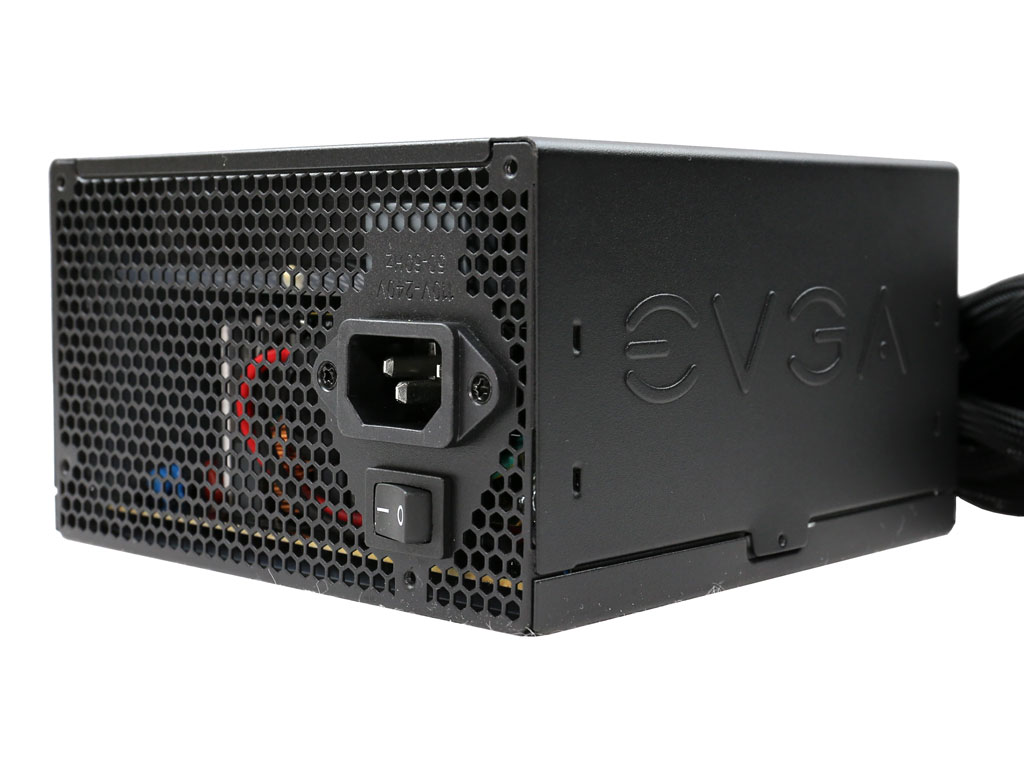Corsair CX450 PSU Review: Two Flavors, Tested and Compared
Why you can trust Tom's Hardware
Load Regulation, Hold-Up Time & Inrush Current
To learn more about our PSU tests and methodology, please check out How We Test PSUs.
Primary Rails and 5VSB Load Regulation
Load regulation testing is detailed here.


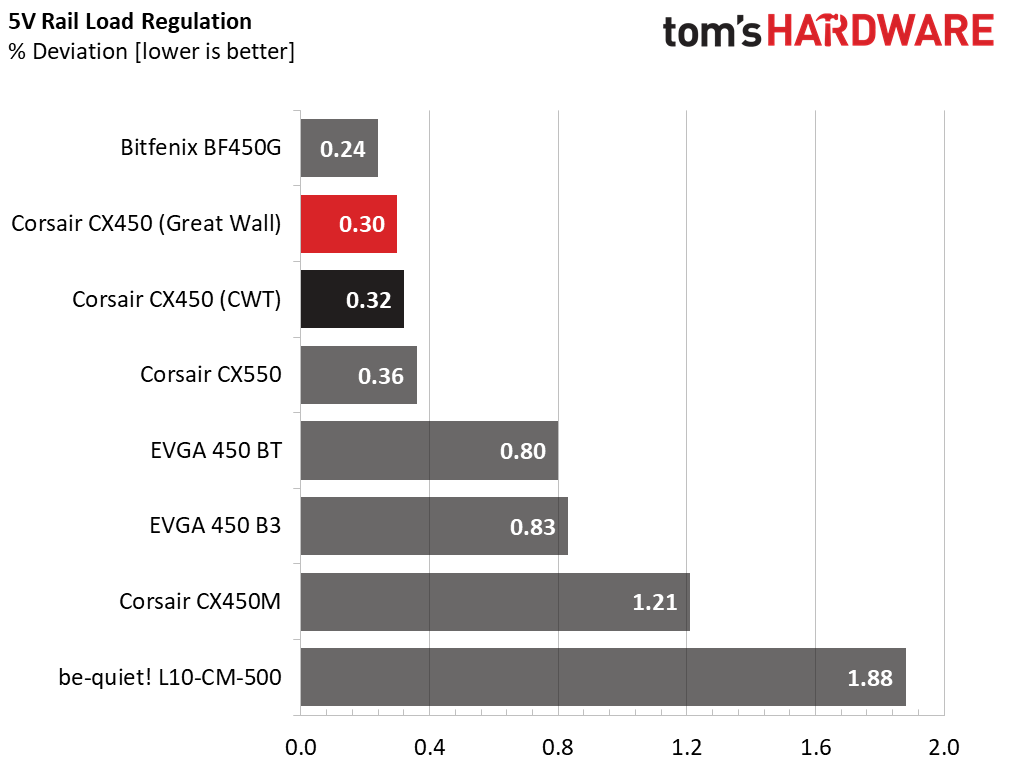
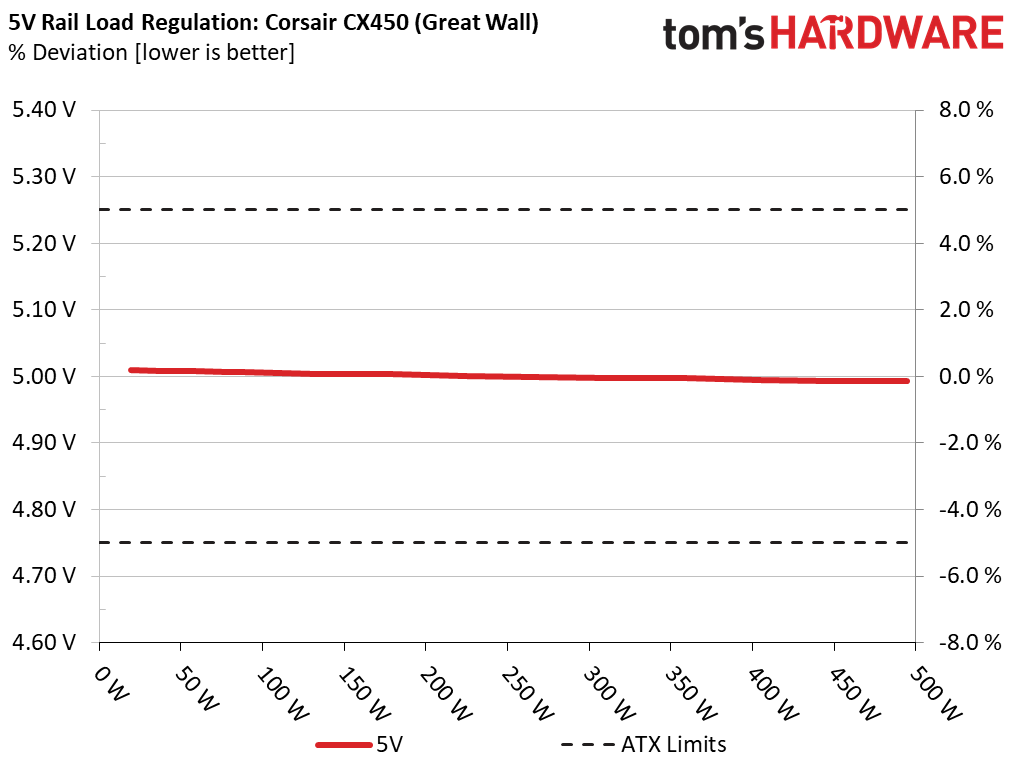
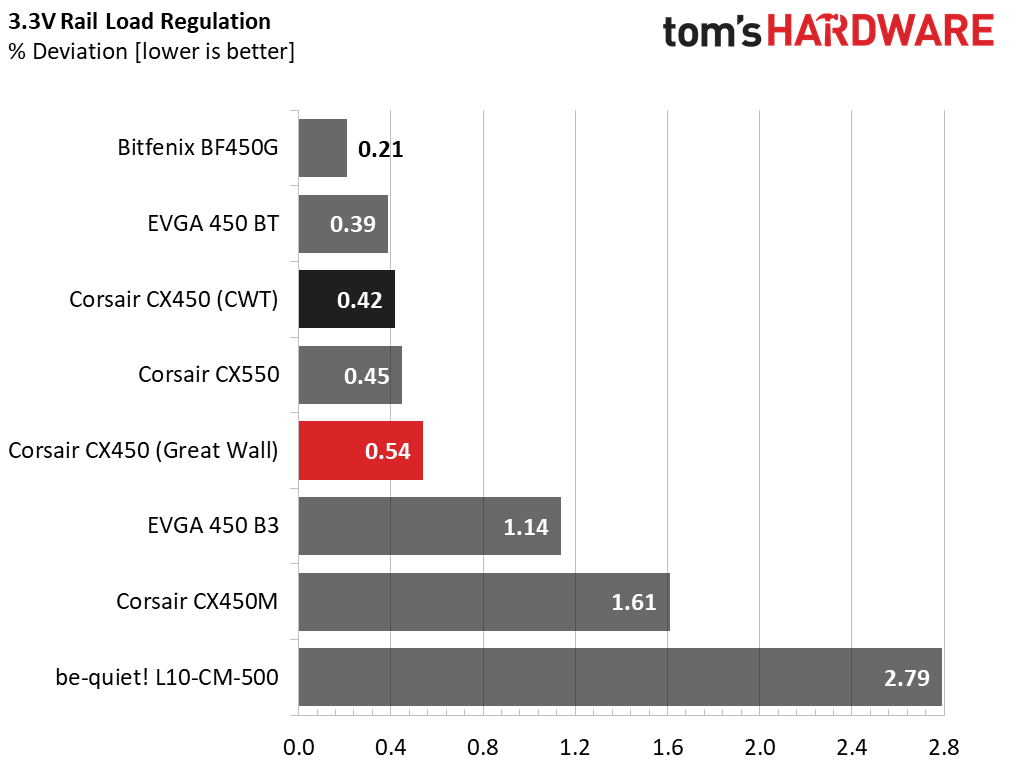
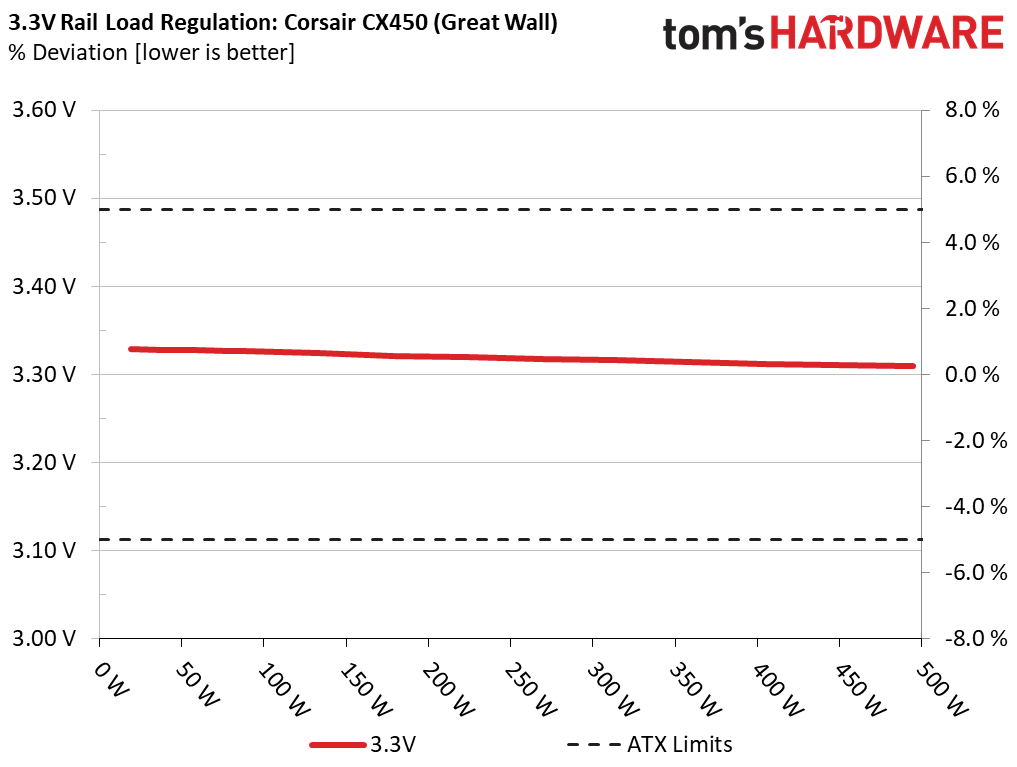
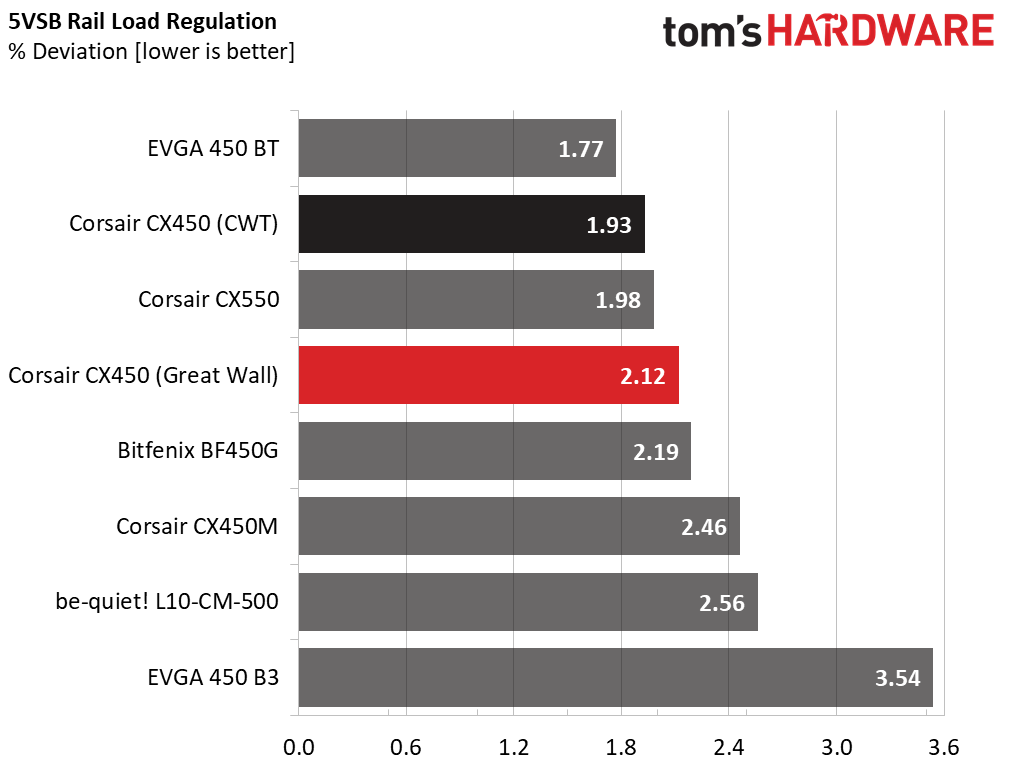
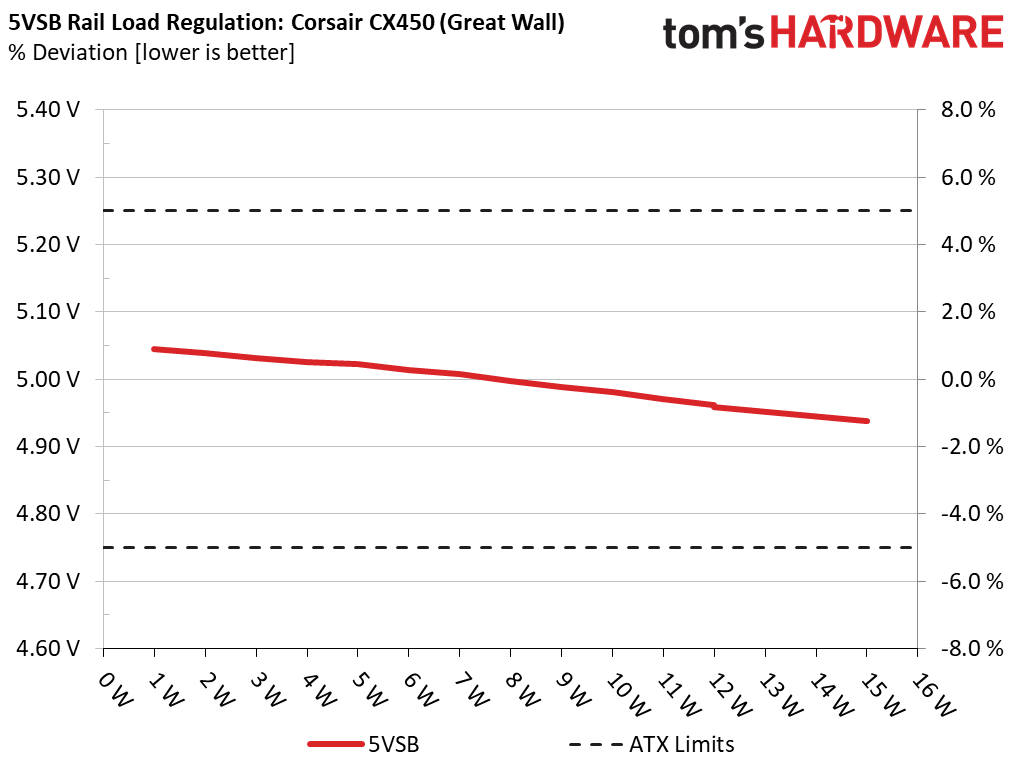
Hold-Up Time
Our hold-up time tests are described in detail here.

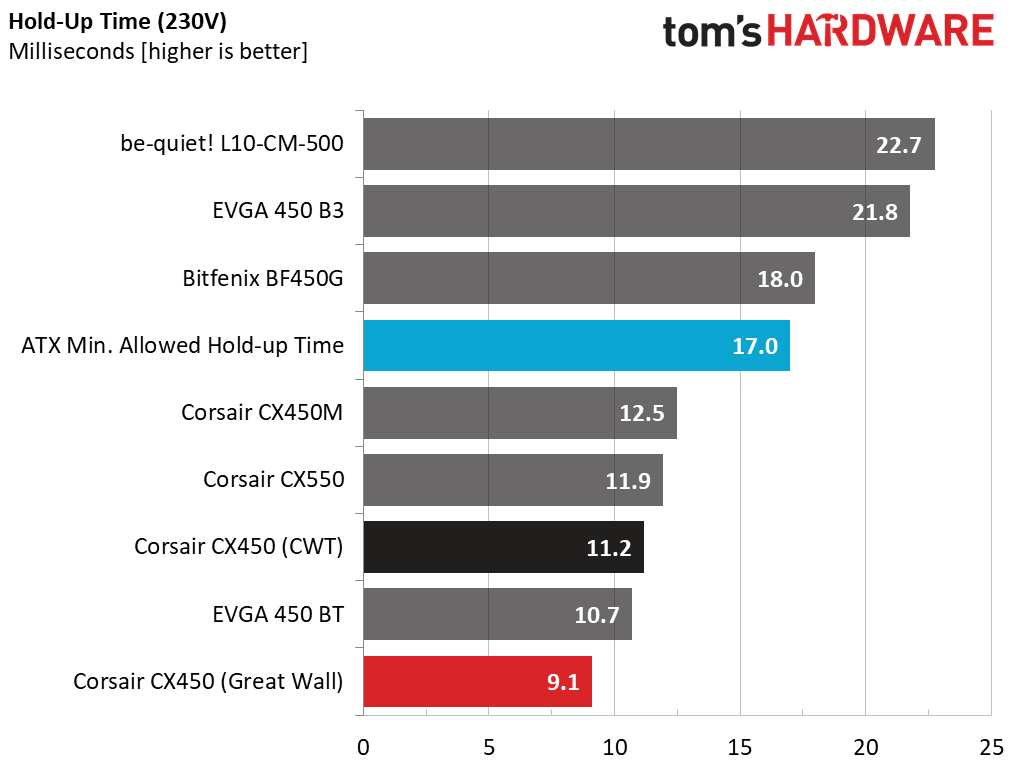



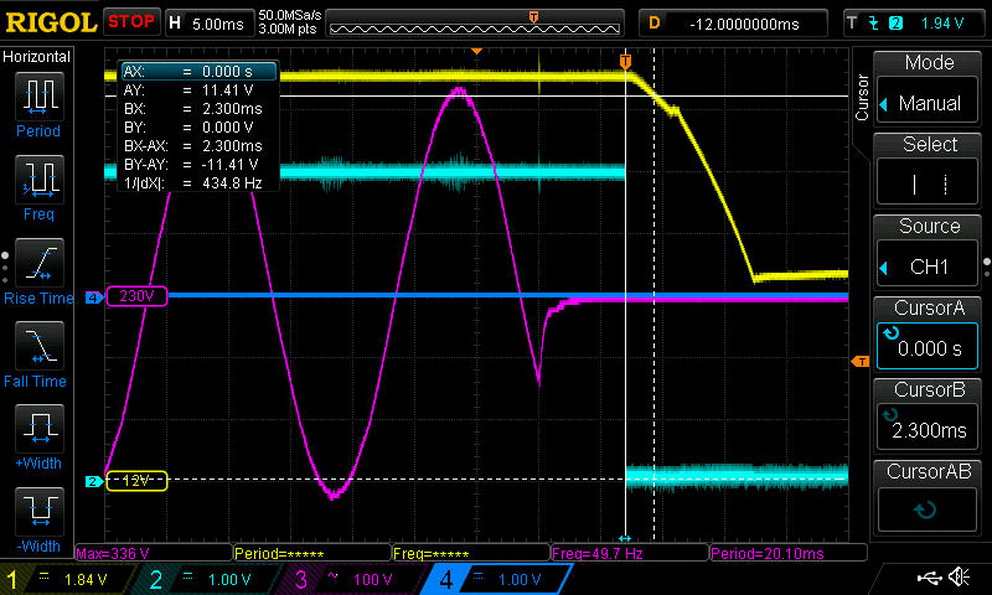
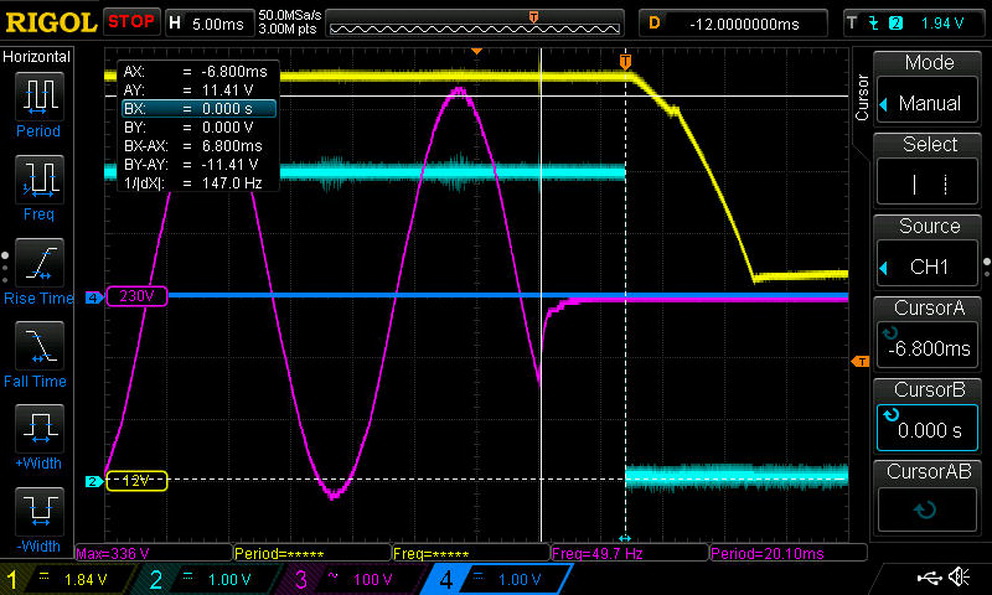
The hold-up time was very low, but at least the power-good signal was accurate. CWT's design performed better, despite its lower-capacity bulk cap. However, it still fell short of the 17 millisecond (ms) hold-up time that the ATX spec requires.
Inrush Current
For details on our inrush current testing, please click here.
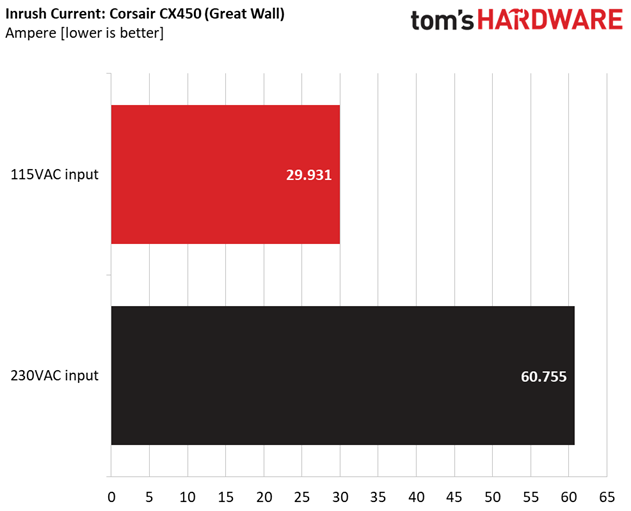

We measured high inrush currents from Great Wall's platform with 230V input, while CWT's fared notably better with both voltage inputs.
Load Regulation & Efficiency Measurements
The first set of tests revealed the stability of the voltage rails and the CX450’s efficiency. The applied load equals (approximately) 10 to 110 percent of the PSU's maximum load in increments of 10 percentage points.
Get Tom's Hardware's best news and in-depth reviews, straight to your inbox.
We conducted two additional tests. During the first, we stressed the two minor rails (5V and 3.3V) with a high load, while the load at +12V was only 0.1A. This test reveals whether a PSU is compatible with Intel's C6/C7 sleep states or not. In the second test, we determined the maximum load the +12V rail could handle with minimal load on the minor rails.
Corsair CX450 - CWT
| Test # | 12V | 5V | 3.3V | 5VSB | DC/AC (Watts) | Efficiency | Fan Speed | PSU Noise | Temps (In/Out) | PF/AC Volts |
|---|---|---|---|---|---|---|---|---|---|---|
| 1 | 1.925A | 1.974A | 1.998A | 0.986A | 44.755 | 76.962% | 818 RPM | 13.8 dB(A) | 37.88°C | 0.977 |
| 12.056V | 5.053V | 3.296V | 5.058V | 58.152 | 44.53°C | 115.12V | ||||
| 2 | 4.888A | 2.962A | 3.002A | 1.186A | 89.727 | 83.357% | 818 RPM | 13.8 dB(A) | 38.08°C | 0.991 |
| 12.047V | 5.052V | 3.294V | 5.049V | 107.642 | 45.12°C | 115.12V | ||||
| 3 | 8.208A | 3.467A | 3.519A | 1.386A | 134.899 | 85.645% | 818 RPM | 13.8 dB(A) | 38.55°C | 0.995 |
| 12.039V | 5.050V | 3.293V | 5.041V | 157.510 | 46.96°C | 115.12V | ||||
| 4 | 11.520A | 3.961A | 4.006A | 1.585A | 179.790 | 86.487% | 818 RPM | 13.8 dB(A) | 39.06°C | 0.996 |
| 12.033V | 5.049V | 3.293V | 5.034V | 207.881 | 48.52°C | 115.12V | ||||
| 5 | 14.490A | 4.960A | 5.010A | 1.791A | 224.794 | 86.423% | 1015 RPM | 21.1 dB(A) | 39.74°C | 0.997 |
| 12.027V | 5.048V | 3.290V | 5.026V | 260.110 | 49.64°C | 115.12V | ||||
| 6 | 17.481A | 5.946A | 6.017A | 1.991A | 269.741 | 86.157% | 1286 RPM | 28.5 dB(A) | 40.52°C | 0.998 |
| 12.011V | 5.045V | 3.289V | 5.017V | 313.081 | 50.58°C | 115.12V | ||||
| 7 | 20.458A | 6.944A | 7.022A | 2.196A | 314.715 | 85.560% | 1578 RPM | 34.1 dB(A) | 41.67°C | 0.998 |
| 12.006V | 5.043V | 3.287V | 5.007V | 367.830 | 52.20°C | 115.12V | ||||
| 8 | 23.440A | 7.935A | 8.034A | 2.400A | 359.676 | 84.894% | 1630 RPM | 35.1 dB(A) | 42.14°C | 0.998 |
| 12.000V | 5.042V | 3.285V | 4.998V | 423.679 | 53.14°C | 115.12V | ||||
| 9 | 26.871A | 8.439A | 8.553A | 2.401A | 404.800 | 84.164% | 1630 RPM | 35.1 dB(A) | 44.01°C | 0.998 |
| 11.990V | 5.041V | 3.284V | 4.993V | 480.965 | 56.41°C | 115.12V | ||||
| 10 | 30.031A | 8.936A | 9.042A | 3.011A | 449.570 | 83.142% | 1630 RPM | 35.1 dB(A) | 45.34°C | 0.998 |
| 11.983V | 5.039V | 3.284V | 4.977V | 540.723 | 60.06°C | 115.12V | ||||
| 11 | 33.815A | 8.934A | 9.044A | 3.015A | 494.534 | 82.117% | 1630 RPM | 35.1 dB(A) | 46.52°C | 0.998 |
| 11.972V | 5.039V | 3.283V | 4.972V | 602.234 | 64.16°C | 115.12V | ||||
| CL1 | 0.100A | 13.019A | 13.004A | 0.005A | 109.758 | 80.682% | 1381 RPM | 30.8 dB(A) | 44.16°C | 0.993 |
| 12.046V | 5.049V | 3.291V | 5.047V | 136.038 | 53.00°C | 115.13V | ||||
| CL2 | 37.478A | 1.004A | 1.003A | 1.002A | 462.348 | 83.718% | 1630 RPM | 35.1 dB(A) | 44.95°C | 0.998 |
| 11.979V | 5.046V | 3.289V | 5.024V | 552.268 | 59.21°C | 115.12V |
Corsair CX450 - Great Wall
| Test # | 12V | 5V | 3.3V | 5VSB | DC/AC (Watts) | Efficiency | Fan Speed | PSU Noise | Temps (In/Out) | PF/AC Volts |
|---|---|---|---|---|---|---|---|---|---|---|
| 1 | 1.924A | 1.995A | 1.982A | 0.996A | 44.813 | 80.582% | 1230 RPM | 27.6 dB(A) | 40.07°C | 0.955 |
| 12.070V | 5.008V | 3.328V | 5.023V | 55.612 | 45.61°C | 115.31V | ||||
| 2 | 4.841A | 2.998A | 2.976A | 1.197A | 89.319 | 85.465% | 1340 RPM | 29.3 dB(A) | 40.76°C | 0.981 |
| 12.066V | 5.006V | 3.326V | 5.014V | 104.509 | 46.71°C | 115.25V | ||||
| 3 | 8.162A | 3.498A | 3.457A | 1.398A | 134.428 | 87.103% | 1395 RPM | 31.5 dB(A) | 41.09°C | 0.988 |
| 12.060V | 5.004V | 3.324V | 5.007V | 154.333 | 48.21°C | 115.19V | ||||
| 4 | 11.484A | 3.997A | 3.973A | 1.601A | 179.644 | 87.516% | 1575 RPM | 35.1 dB(A) | 41.74°C | 0.990 |
| 12.056V | 5.003V | 3.321V | 4.998V | 205.269 | 50.76°C | 115.13V | ||||
| 5 | 14.475A | 5.000A | 4.971A | 1.804A | 224.927 | 87.265% | 1710 RPM | 37.7 dB(A) | 42.12°C | 0.992 |
| 12.050V | 5.001V | 3.319V | 4.989V | 257.751 | 51.89°C | 115.07V | ||||
| 6 | 17.403A | 6.003A | 5.966A | 2.008A | 269.436 | 86.899% | 1865 RPM | 40.2 dB(A) | 42.81°C | 0.993 |
| 12.046V | 4.999V | 3.317V | 4.981V | 310.057 | 53.15°C | 115.10V | ||||
| 7 | 20.396A | 7.006A | 6.967A | 2.213A | 314.729 | 86.036% | 1865 RPM | 40.2 dB(A) | 43.11°C | 0.994 |
| 12.042V | 4.998V | 3.316V | 4.971V | 365.809 | 54.46°C | 115.03V | ||||
| 8 | 23.392A | 8.007A | 7.966A | 2.419A | 360.029 | 85.148% | 1865 RPM | 40.2 dB(A) | 43.83°C | 0.995 |
| 12.039V | 4.997V | 3.314V | 4.962V | 422.828 | 55.64°C | 114.97V | ||||
| 9 | 26.793A | 8.508A | 8.456A | 2.421A | 404.935 | 83.918% | 1870 RPM | 40.3 dB(A) | 44.22°C | 0.995 |
| 12.034V | 4.995V | 3.312V | 4.958V | 482.539 | 56.86°C | 114.89V | ||||
| 10 | 29.931A | 9.014A | 8.975A | 3.038A | 449.755 | 82.743% | 1865 RPM | 40.2 dB(A) | 45.32°C | 0.994 |
| 12.029V | 4.993V | 3.310V | 4.938V | 543.555 | 58.66°C | 114.87V | ||||
| 11 | 33.661A | 9.014A | 8.974A | 3.042A | 494.583 | 81.830% | 1865 RPM | 40.2 dB(A) | 46.51°C | 0.994 |
| 12.028V | 4.993V | 3.309V | 4.933V | 604.405 | 60.88°C | 114.85V | ||||
| CL1 | 0.136A | 13.001A | 12.999A | 0.000A | 109.905 | 81.270% | 1862 RPM | 40.1 dB(A) | 43.10°C | 0.987 |
| 12.056V | 5.004V | 3.324V | 5.029V | 135.234 | 54.76°C | 115.21V | ||||
| CL2 | 37.419A | 1.003A | 1.001A | 1.000A | 463.776 | 83.467% | 1873 RPM | 40.3 dB(A) | 45.55°C | 0.995 |
| 12.038V | 4.999V | 3.314V | 4.994V | 555.639 | 59.00°C | 114.91V |
Both PSUs demonstrated good load regulation. However, Great Wall's version won in this particular comparison. Its fan spun aggressively once the operating temperatures started climbing. But we expected that from a lower-efficiency power supply. On the other hand, though, CWT's fan profile was more relaxed under the same operating conditions.
The two CX450s delivered their full power without any problems at ambient temperatures greater than 46°C (113°F) . And both easily met 80 PLUS requirements for Bronze certification, even under our tough operating conditions.
MORE: Best Power Supplies
MORE: How We Test Power Supplies
MORE: All Power Supply Content
Current page: Load Regulation, Hold-Up Time & Inrush Current
Prev Page Teardown & Component Analysis Next Page Efficiency, Temperature & Noise
Aris Mpitziopoulos is a contributing editor at Tom's Hardware, covering PSUs.
-
jpe1701 Oh thank you Aris, I've been waiting for a review of this. It's always low in price and tempting to recommend but there weren't any reviews.Reply -
Darkbreeze Why do both of the review summary boxes list the Great Wall version? Both the one on the front page and the last page are the same. Seems like you ought to include a summary box for both versions since there seems to be some major differences between them. And even more so since you seem to indicate the CWT version is the better unit, but only include a summary box for the Great Wall unit.Reply -
Darkbreeze I totally understand. No worries mate. Editorial has a bad habit of effectively pooping all over the independent contributors writing as well. Not surprising that they are doing so with your work, but I sure wish somebody in editorial would make a few changes to policy that keeps the finished product a bit more in line with what the contributor intended, which often they don't. In this case, it totally makes zero sense that they didn't leave it as you had it.Reply -
Rexper ReplyWe preferred CWT's version of Corsair's CX450, but that doesn't mean you should avoid Great Wall's
Not that we have a choice.
Great article, once again, Aris!
There is some controversy appearing relating to the fan bearings used in the CX450. JonnyGURU, who works at Corsair, claims both CX450 versions use a rifle bearing.
Unfortunately, we can't know for certain until someone dismantles the fan.
http://www.jonnyguru.com/forums/showthread.php?t=15943&page=2 -
Darkbreeze I don't think it even makes a tremendous amount of difference. Fan failure on power supplies due to bearing fatigue is the least of the issues I've usually seen in the past on older units. Plus, it's not terribly difficult to replace a PSU fan if you have at least of a modicum of common sense and don't possess four thumbs.Reply
If fan noise is the biggest worry, or bearing failure over the long term, then I'd say these are winners for the price point. Most would never hear them over the sound of the rest of the system in any case.


